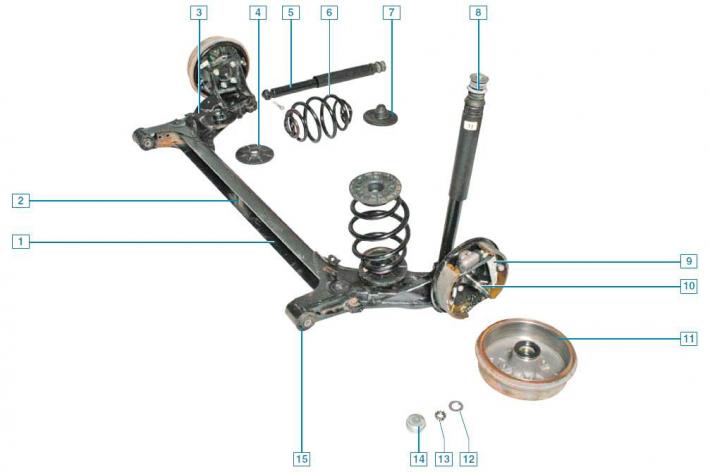
Rear suspension elements: 1 - beam; 2 - rubber cushion; 3 - beam lever; 4 - lower spring gasket; 5 - shock absorber; 6 - spring; 7 — the top laying of a spring; 8 - pillows and washers of the upper attachment of the shock absorber to the body; 9 - brake mechanism of the rear wheel; 10 - trunnion of the rear wheel; 11 - brake drum assembly with rear wheel bearings; 12 - thrust washer; 13 - castellated nut; 14 - protective cap; 15 — silent block beam lever
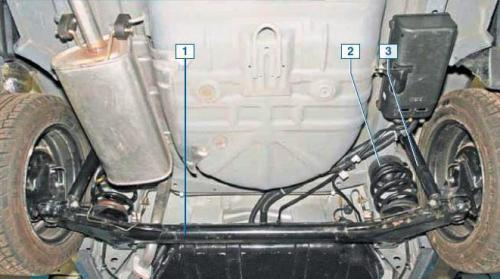
Rear suspension: 1 - rear suspension beam; 2 - spring; 3 - shock absorber
The rear suspension is semi-independent with an elastic beam and trailing arms hinged to the body, with barrel springs and double-acting telescopic shock absorbers.
To increase the lateral stability and reduce the roll angles, a stabilizer bar is installed inside the beam, the ends of which are fixed to the suspension arms with bolts and nuts.
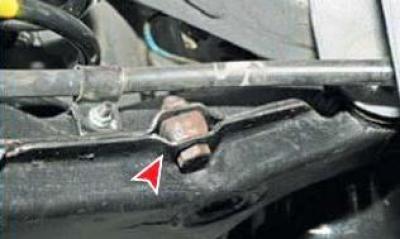
The anti-roll bar is attached with a bolt and nut to the suspension arm.
A rubber cushion is installed in the middle part of the stabilizer to eliminate vibration of the rod.
The main bearing element of the suspension is a beam consisting of trailing arms and a connector welded together.
At the rear, brackets for mounting shock absorbers and flanges for attaching rear wheel trunnions and brake shields are welded to the suspension arms.
Silent blocks are pressed into the eyelets of the levers at the front.
Rubber array of silent block, vulcanized to clips.
When pressing the silent block into the lever, it must be strictly oriented.
A bolt passes through the inner cage of the silent block, connecting the lever to the body bracket.
The elastic elements of the suspension are helical barrel-shaped springs.
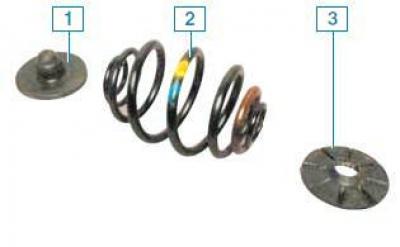
Rear Suspension Spring: 1 — the top laying of a spring; 2 - spring; 3 - lower spring gasket
A plastic cover is glued to the second turn from below.
The upper end of the suspension spring rests through a rubber gasket on a platform welded to the side member of the body, the lower end - through a rubber gasket, on a bracket welded to the beam arm.
The rubber pad on the top end of the spring also acts as a buffer for the compression stroke.
A rubber-metal hinge is pressed into the lower eye of the shock absorber, through the central bushing of which a bolt passes, which fastens the shock absorber to the suspension arm.
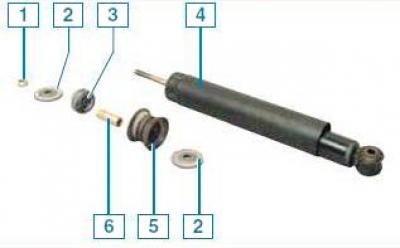
Rear shock absorber: 1 - rod fastening nut; 2 - washer; 3 - top pillow; 4 - shock absorber; 5 - bottom cushion; 6 - spacer sleeve
The shock absorber rod is attached to the body through two rubber cushions (one is at the bottom of the support, the other is at the top) and two metal washers.
A spacer sleeve is installed between the cushions on the shock absorber rod.
The role of the rear wheel hub is performed by a brake drum in which two tapered roller bearings are installed.
The outer rings of the bearings are installed in the drum with a slight interference fit.
Inner races of bearings mounted on a trunnion (axes) rear wheel - with a small gap.
The rear wheel trunnion is fastened with four nuts through the brake shield to the flange of the rear suspension beam
The angles of installation of the rear wheels are structurally made by the manufacturer and are not adjustable.
The values of the rear wheel alignment angles for a car with a half-filled fuel tank and a load of 70 kgf on the front seats:
- – camber: from –2°10' up to -1°10';
- – convergence: –10'±40' (–1±4 mm).
If the measured values of the angles do not correspond to those set, it is necessary to check the condition of the suspension.
